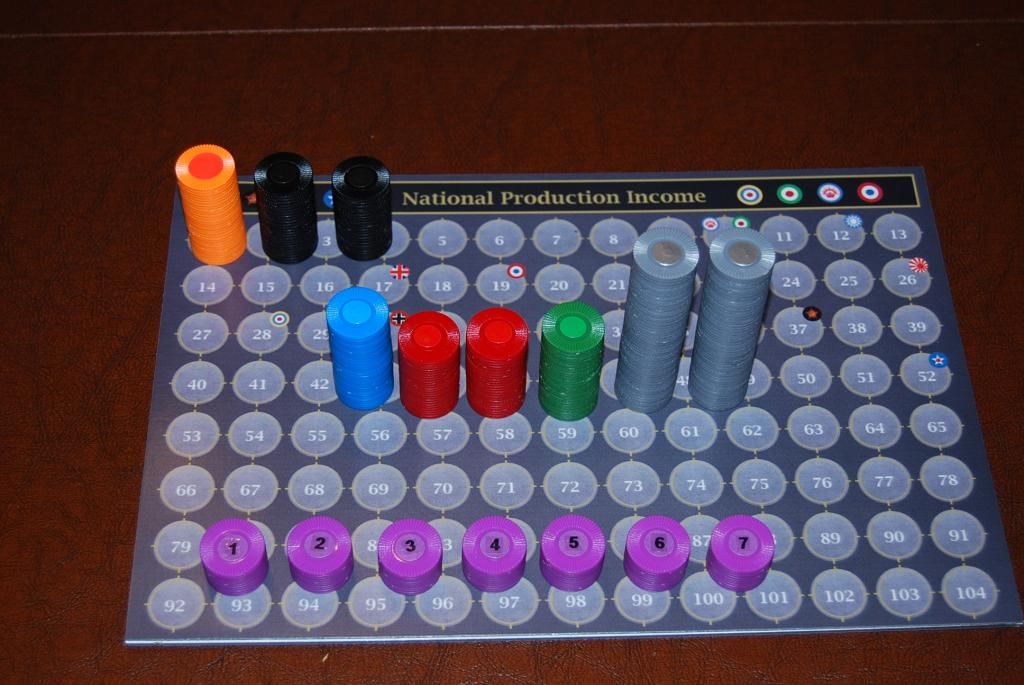Awesome! I’ll get to it eventually.
Best practice of keeping tracking movement and etc
-
Any suggestions as to how best to keep track of lands units that already moved in combat move, and airplanes and their remaining moves?
Or any other suggestions in general. One of the problems I found (and I’m sure many have found this as well) is after 5 hours of playing AA, players tend to forget details like movement.
-
We put units on their side and use small dice as markers for the Air units, with the dice showing the remaining number of moves.
-
I know there are some movement markers you can get with numbers on them. Ike had some when I used to play over at his place. Maybe shoot him a message to see where he got them (likely from HBG)
Otherwise, the best method is to stick to the rules: don’t mix combat and non-combat. When planes take off for battle figure out where they are landing beforehand and declare it (you can change your mind of course, but putting it out there will at least help).
The biggest confusion comes from blurring the combat/non-combat lines
-
@wittmann:
We put units on their side and use small dice as markers for the Air units, with the dice showing the remaining number of moves.
This is a great suggestion witt, especially the dice for air units.
-
We use magnetic markers with numbers on them.
Fuel Markers
Purple (numbered 1-7) These are my new chips to mark the spaces left that a plane can fly after combat. With so many planes in global 1940 we found it useful.

-
We also have the small, FMG dice though they were quite expensive. A strict division of combat/noncoms is helpful.
Another method is to count airplane movement by orientation;
0: plane faces north
1: plane faces east
2: plane faces south
3; plane faces west
4; plane inverted, faces north
5; plane inverted, faces eastdon’t forget that planes that have them most moves left would be lost last, so that if any fudging/goof ups had occurred, (such as having fighters with 1, 2 and 3 moves left in the same battle but forgetting which ones were which), if only one survives, it has 3 moves left.
When you do your combat moves, move the pieces furthest away first, and the closest to the battle last. This helps show what pieces can reach only one battle vs more than one battle.
When you place stacks of especially Axis units, place them pre-broken for transport. 4 men and 3 arty is represented by 3 men in one stack, one single man, 2 arty in one stack, one single arty. This avoids having to constantly break a stack that will have to be divided after setup but imm. before combat begins, which avoids muddling various stacks.
Then, during noncoms, move the pieces furthest from the battlefront first, finishing with the units closest to the front.
Clean game.
-
For ships we always have all ships horizontally. Until they move and we place them vertically. This is really helpful with countries like Japan. Good to see what transports already moved , what subs have moved etc. Even when we don’t move ships in non combat, we place them vertically, so we know that’s the plan (to not move them). Round two is the same, but then all ships are placed horizontally again. Really simple, but really helpful.
-
We use the army pieces from the 2008 RISK as movement trackers.
I have seen a lot of people use the cities from this game as Industrial complexes and such.
The army pieces are arrows with either 1 chevron or 3 chevrons. So when we move something we place the corresponding arrow piece. Once all the units movement points are spent we flip the arrow upside down.






